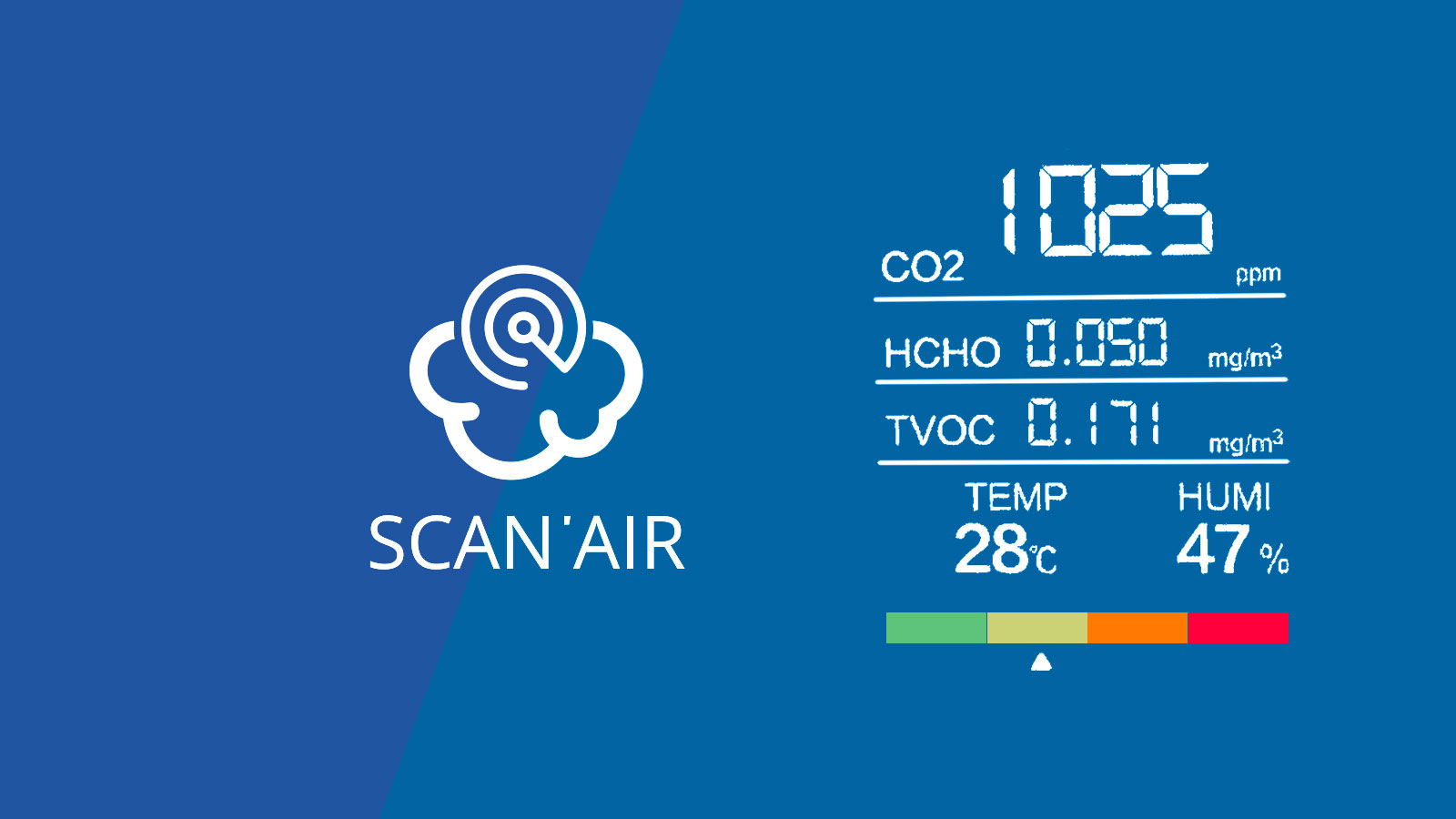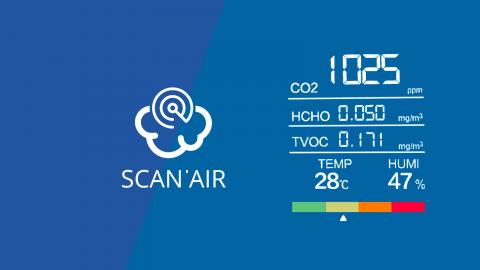
Air analyzer: Understanding the values and rates displayed ?
The values displayed by indoor air quality testers are often for the uninitiated a series of numbers and acronyms that are not always understandable.
By following this guide you will become an expert on IAQ and air analyzers. VOC, CO2, PM25, PM10, formaldehyde, CO, we will break down the essentials of these values for you, the standards, the alert thresholds and their effects on health.
CO2: Carbon dioxide in indoor air.
Symbol : CO2
Unit of measurement: ppm
Carbon dioxide (CO2) is a natural component of the air we breathe; it is a colourless and odourless gas that is naturally produced by living things during breathing for example, or also by the combustion of various products.
CO2 at high levels in a room is an indication of insufficient ventilation for the number of occupants in the room. The quantities of CO2 detected are often misinterpreted and confused with carbon monoxide (CO) which is more dangerous. It is only in very high concentrations in the air that CO2 becomes harmful.
Key values for CO2 in the air :
300 à 1000 ppm
Air bien ventilé
Qualité de l’air normale
1000 à 5000 ppm
Air mal ventilé
Fatigue intellectuelle & diminution de la concentration
5000 à 20 000 ppm
Air Vicié
Risques élevés sur la santé, exposition courte uniquement.
20 000 ppm à 100 000 ppm
Air dangereux
Dégradation de la santé et risque de décès.
CO :carbon monoxide in indoor air.
Symbol: CO
Unit of measurement: ppm
Carbon monoxide (CO) is a toxic gas that is extremely dangerous to our health. It is colourless, odourless and non-irritating. It cannot be detected without equipment.
It is an asphyxiating gas which, once it has entered the lungs, takes the place of oxygen in the blood. In case of exposure, death by carbon monoxide poisoning can occur within an hour. Symptoms that should alert you are: headaches, nausea and vomiting.
In indoor air, its presence results from incomplete combustion of the fuel used: wood, gas, coal, oil, candles, petrol, etc.
The values of CO in the air to remember :
0 à 0,2 ppm
Air bien ventilé
Concentration normale dans l’air ambiant intérieur.
0,2 à 1 ppm
Air mal ventilé
Concentration anormale, identifier la source de pollution.
20 ppm / 40h / Semaine
Limite maximal pour un travailleur.
Concentration moyenne considérée comme inoffensive pour un travailleur exposé 40 heures par semaine pendant toute sa carrière.
100 ppm / 15 min
Concentration maximale
Concentration maximum autorisée pendant 15 minutes sur un lieu de travail.
Le Saviez-vous :
Valeurs de Monoxyde de carbone (CO) considérées comme inoffensives par l’OMS en fonction du temps d’exposition
- 9 PPM < 8 HEURES : Exposition maximale pendant 8 heures.
- 26 PPM < 1 HEURES : Exposition maximale pendant 1 heure.
- 52 PPM < 30 MINUTES : Exposition maximale pendant 30 minutes.
- 90 PPM < 15 MINUTES : Exposition maximale pendant 15 min.
COV: Volatile Organic Compounds in Indoor Air
Symbols : COV , VOCs , TVOC , TCOV
Unit of measurement : µg /m3 ou µg.m-3, mg/m3
COV(Volatile Organic Compounds) in indoor air are a collection of more than 165 microscopic airborne chemical or organic substances. Common sources of COV indoors are: cooking, smoking, DIY, cleaning, household appliances, furniture and pets.
COV have undesirable short-term effects: discomfort, odours, drowsiness, irritation, but also health effects with the development or aggravation of respiratory pathologies and allergies. In the long term, COV are also the source of certain cancers and degenerative diseases.
COV are all different and have different maximum concentrations depending on the molecule. Thus, global monitoring of COV cannot replace precise monitoring of the molecules according to the sources of pollution in the place. Nevertheless, the decree n° 2011-321 of 25 March 2011 defines some rules on the general rate of admissible COV.
Relevant values for COV in air :
0 à 10 μg/m3
Concentration faible, Air bien ventilé
Qualité de l’air normale (Hors CMR)
10 à 600 μg/m3
Air mal ventilé
Concentration forte, aérer la pièce régulièrement ou renouveler l’air avec un purificateur.
600 à 1000 μg/m3
Air Vicié
Concentration critique, mauvaise qualité de l’air, identifier la source de pollution.
1000 - 9999 µg /m3
Air dangereux
Concentration Dangereuse, air vicié : Aérer et sortir de la pièce.
PM10 & PM25: Fine particles in indoor air
Symbols : PM10, PM25, PM2.5, PM2,5
Unit of measurement : µg /m3 ou µg.m-3
Microparticles or fine particles are mainly generated by heating, transport and industry, but they also come from spores, certain aerosol products or combustion by-products (tobacco, candles, cooking, etc.). It should be noted that some COV are also fine particles.
They are generally referred to as PM10 (particles smaller than 10 μm) and PM2.5 (smaller than 2.5 μm). However, indoor air also contains a large number of ultrafine particles: PM1 (smaller than 1 μm).
Each particle penetrates the body in a different way depending on its size and composition, with increasingly dangerous areas of effect as the size of the particles decreases.
PM10 values to remember :
15 μg/m3 / An
Air bien ventilé
Concentration dans l’air maximale en moyenne annuelle (source : OMS)
> 25 μg/m3 / Jour
Air mal ventilé
Concentration maximale dans l’air en moyenne journalière (source : HCSP)
> 50 μg/m3 / Jours
Air Vicié
Moyenne journalière maximale à ne dépasser pas plus de 35 jours par an (OMS)
> 70 μg/m3 / Jour
Air dangereux
Moyenne journalière dangereuse, Danger immédiat, actions correctives obligatoires (HCSP)
VALUES TO REMEMBER FOR PM2.5
< 5 μg/m3 / An
Air bien ventilé
Concentration maximale dans l’air en moyenne annuelle (source : OMS)
> 15 μg/m3 / Jour
Air mal ventilé
Concentration dans l’air maximale en moyenne journalière (source : OMS)
> 25 μg/m3 / Jours
Air Vicié
Limite à ne pas dépasser plus de 3 jours par an (OMS)
> 50 μg/m3 / Jour
Air dangereux
Limite de danger immédiat, actions correctives obligatoires (HCSP)
Did you know :
PM1 and PM0.1 VALUES
To date, these particles are under study, but there are no recommendations on the concentration limits of PM1 in the air.
Formaldehyde in indoor air
Symbols : Formaldehyde, HCHO,
Unit of measurement: μg/m3, mg/m3 ou ppm
Formaldehyde is a colorless, suffocating, flammable gas and classified as a carcinogen. It is frequently present in indoor air. Formaldehyde is used as a disinfectant, as a fixative and as a binder in resins (do-it-yourself products, maintenance, wall and floor coverings, furniture, plastics...). It is found in large quantities in the veterinary, cosmetic, medical, industrial and agricultural sectors...
Did you know :
The presence of formaldehyde is important in France in the air of housing.
According to measurements made in recent years: 4% of homes in France would have concentrations of formaldehyde greater than or equal to the limit value.
According to an Ineris study of 2004, the average concentration in the outdoor air in France is 4 to 10 µg/m3 and 22 to 25 µg/m3 indoors.
The values to remember for formaldehyde in the air :
0 à 10 μg/m3
Limite conseillé en 2023
Limite maximale fixée par la France pour le 1er janvier 2023.
10 à 30 μg/m3
Limite en 2015
Limite maximale en cours en France depuis 2015
37 μg/m3 / 8h
Limite au travail
Limite d’exposition au travail pendant 8 heures par jour
74 μg/m3 / 15 min
Limite au travail
Limite d’exposition au travail pendant 15 minutes par jour.

